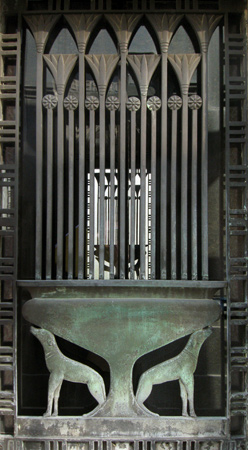Another Egyptian-inspired Art Deco mausoleum, albeit a little less decorative than the Barris family vault:
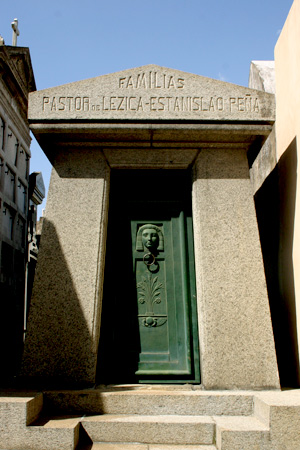
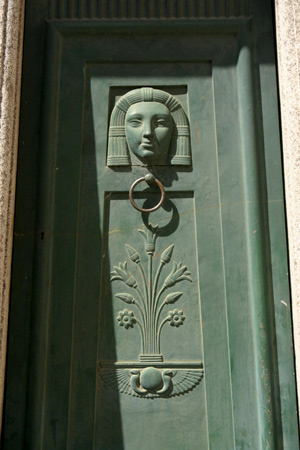
Another Egyptian-inspired Art Deco mausoleum, albeit a little less decorative than the Barris family vault:


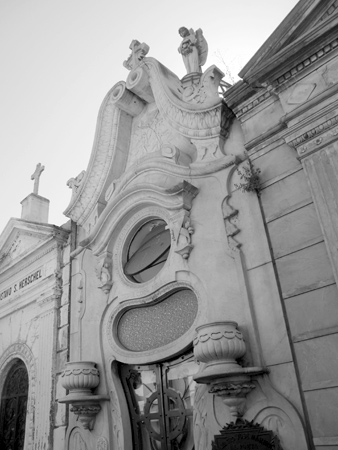
Although labeled as the Sepulcro Milano, one of the first great literary figures of Argentina is buried here—José Mármol. Born in 1818, Mármol became involved in politics at an early age. He didn’t complete his law degree due to fierce opposition & activism against the dictatorial style of Juan Manuel de Rosas. After being imprisoned for arguing with members of the Rosas family, Mármol decided to leave Buenos Aires. He met other anti-Rosas comrades in Montevideo & was inspired to write. When the forces of Rosas invaded Montevideo, Mármol moved even further away… this time to Rio de Janeiro. By the time Rosas was removed from Argentina, Mármol had been away from Buenos Aires for 13 years. From 1845 to 1868, he occupied several government positions. His last duty before going blind & passing away in 1871 was director of the National Library.
In spite of a life dedicated to serving his nation, José Mármol is most remembered for his first novel, Amália. Published in serial form beginning in 1844, the 75-chapter novel successfully mixed romance with current events so well that readers weren’t sure if they were reading fact or fiction.
A quick plot summary: Eduardo Belgrano is wounded in an attempt to escape Buenos Aires & the rule of Rosas. A friend, Daniel, saves Eduardo’s life & gives him refuge in the house of his cousin… a young widow named Amália. Daniel & Amália pretend to support Rosas in order to keep Eduardo safe, & of course this gives time for Eduardo & Amália to fall in love. But as they try to flee Buenos Aires, both are killed by the right-hand man of Rosas. This classic is usually required reading in most Argentine schools, & Mármol’s entire body of work can be found online for free in the public domain.
The tomb is a wonderful interpretation of Art Nouveau, full of curves, vines & depictions of plant life:
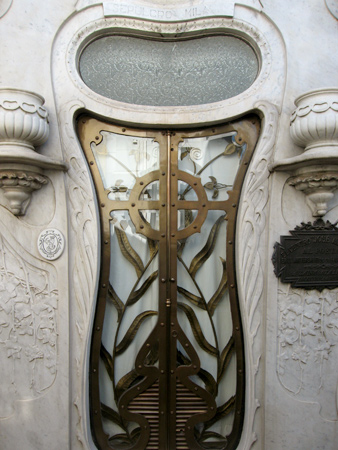
A plaque on the right was given by a cultural center inspired by Mármol:
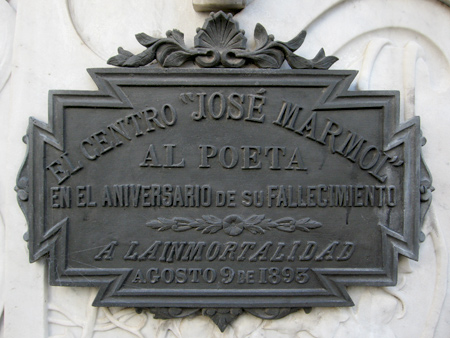
And an oval image of man being swallowed by a crowned “serpent” appears to be a loose interpretation of the Visconti coat-of-arms… surely because this mausoleum was used by Milanese descendants. But how did José Marmol end up here?
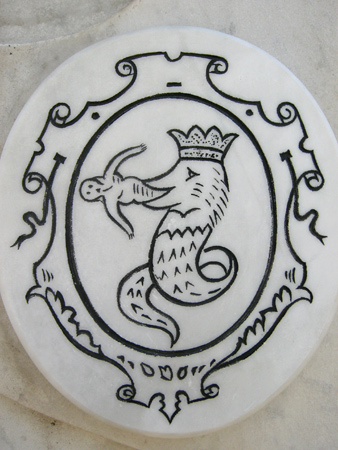
Like Art Nouveau? Learn about the architects of the era, their individual styles & what makes Art Nouveau in Buenos Aires so unique with a 33-page guide from our sister site, Endless Mile.
4 Comments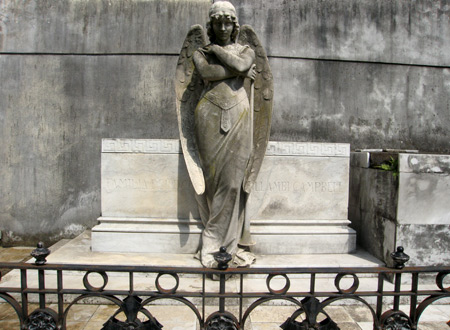
This gated family vault uses only underground storage with little ornamentation above except for one of the most beautiful angels in the cemetery. Paulino Llambi Campbell owned a large amount of land in the Argentine province of Santa Fe & named the area & town after his family.
The angel holds a trumpet in one hand while crossing her arms over her chest. The slightly bowed head is hardly demure… she has a very come-hither look on her face. Add some sensual curves & this is one of the most femme fatale statues in Recoleta Cemetery:
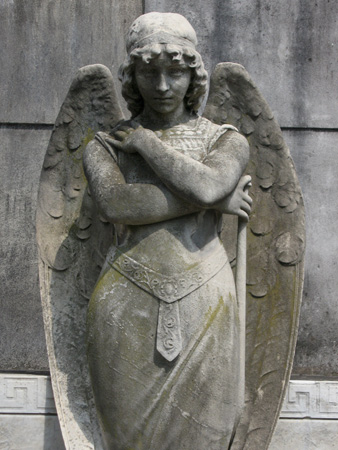
But this statue is not unique. Inspired by a similar angel in Staglieno Cemetery in Genoa, Italy, she makes the Recoleta version seem absolutely tame. The original was made by Giulio Monteverde, an Italian artist who trained Lola Mora & Victor de Pol as well as sculpting the crucifixion inside the entrance gate chapel. Thanks to Sergio Sanginisi for taking such a wonderful photo:
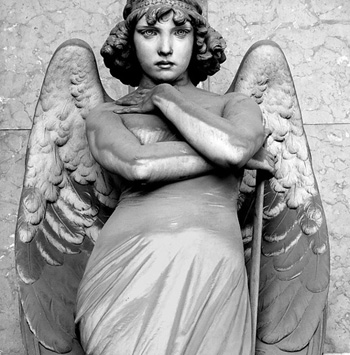
Just above the staircase which descends into the family vault is an inscription in French, “there is no death except for the one who is forgotten.” Thanks to Sergio for helping with the translation:
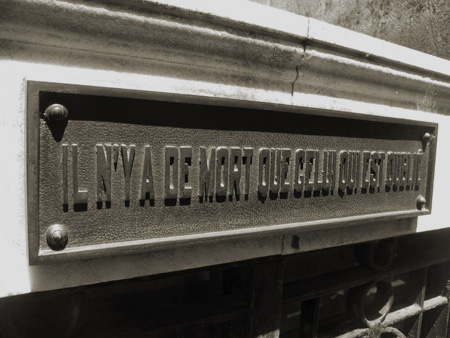
Update (08 Feb 2012): Thanks to the online Witcomb Collection, older versions of Recoleta Cemetery are coming to light. A nearby plot (four mini-blocks to the right) originally belonged to Vicente Ocampo & displayed a more accurate copy of the Staglieno masterpiece. Unfortunately only the Llambi Campbell copy survives today, & the Vicente Ocampo plot has been sold & divided into four sub-plots. I wonder what the Ocampo family did with their copy???

Although the red granite mausoleum of the Barris family doesn’t attract much attention, its decoration certainly does. The 1922 discovery of the tomb of King Tutankhamon drove the world into an Egyptian design craze. Two-dimensional artwork & emphasis on straight lines were also a perfect match for Art Deco. There are several Egyptian-inspired vaults in Recoleta Cemetery, but this is one of the most artistic.
The door incorporates a little bit of everything… an eagle, a cartouche, fantastic bird-ram creatures, some Egyptians & even a scarab. Probably the most relevant decoration is the “ka”—two upraised arms which represent the soul or life force:
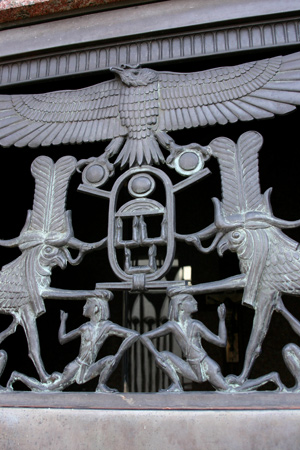
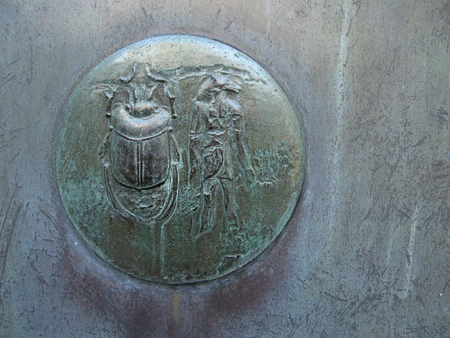
Twin windows with papyrus & a pair of dogs complete the decoration:
